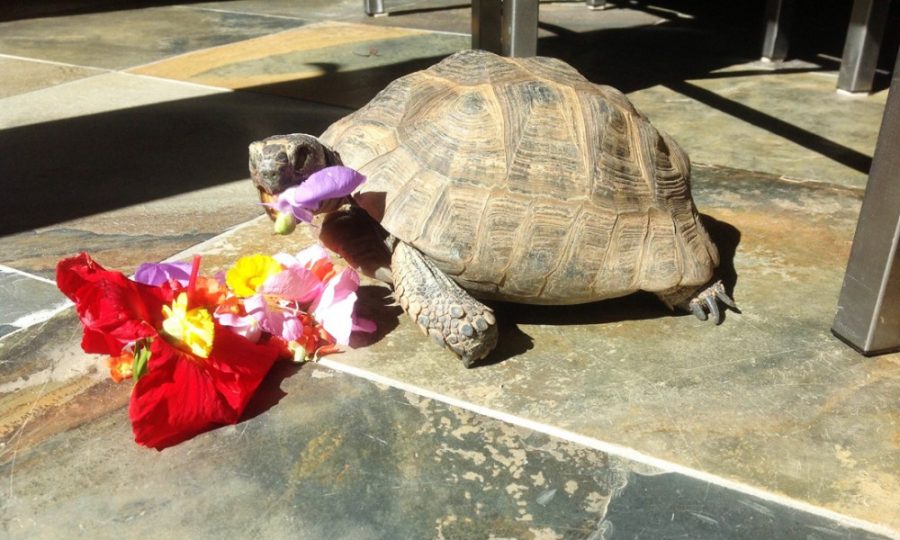Earth Day is an important day to recognize the impact humans can have on the environment and its inhabitants. The Sonoran Desert is full of beauty, from the Saguaro cactus to the luminous pink sunsets; however, one of the most emblematic ambassadors is the Sonoran Desert tortoise.
The Arizona-Sonora Desert Museum’s Tortoise Adoption Program has been working under agreement with the Arizona Game & Fish Department to keep these majestic reptiles in the wild since 1983.
“Our goal is to keep captive tortoises captive, because they are not used to the Arizona environment and also may carry diseases that are harmful to the desert wildlife,” said Renee Lizotte, the Tortoise Adoption Program’s coordinator at the museum.
TAP allows “custodians,” who are approved fosters, to make a habitat and care for already captive desert tortoises.
“They must meet a certain amount of requirements to be a custodian,” said Stephane Poulin, general curator for the museum. “You’re looking at multiple things, which is why we have yard volunteers who evaluate and modify the reptiles’ habitat. It’s best to refer to the website to ensure you have met all the requirements.”
Lizotte is a current custodian herself, taking care of one desert tortoise.
In a case where a tortoise is brought to the museum, an experienced staff member determines if it is in fact a Sonoran Desert tortoise, according to Poulin.
“After identification of the animal [that] has been considered a native desert tortoise, and was found in a wild setting, we would encourage the person to return the tortoise exactly where it was found,” Poulin said.
Poulin also has a Sonoran Desert tortoise, Squirt, who he acquired through the program.
Over the past 30 years, the museum has seen an estimate of 3,000 Sonoran Desert tortoises attend the TAP, according to Poulin. TAP works with an estimated several thousand people in an effort to create a compassionate environment for the tortoises that have been placed in the program.
“Each tortoise that’s going through the program at the Desert Museum is currently being microchipped to keep track of the animal’s history,” Poulin said.
According to Russ Solsky, an affiliate with the herpetology department at the museum, when witnessing this reptile in its natural habitat, it’s important to not disturb it and to understand its relationship to Arizona’s environment.
“What you don’t want to do is to [pick up] a Sonoran Desert tortoise,” Solsky said. “It may get startled and release its emergency reserved water supply in its bladder.”
The desert museum’s TAP mandate is to work with only the native Sonoran Desert tortoise; the museum does not work with other exotic tortoises, Poulin said. If a tortoise other than the Sonoran Desert tortoise is found, it is best to contact the Arizona Game & Fish Department for further instruction.
The Sonoran Desert Tortoises, when taken captive as pets, are exposed to diseases from domestication, according to an article on the Arizona Game & Fish Department’s website.
The U.S. Fish and Wildlife Service currently considers the Sonoran Desert tortoise as a candidate for being endangered. In the next few months, Poulin said, there will be a ruling by the U.S. Fish and Wildlife Service to determine if the tortoise is endangered or not.
If considering any captive tortoise as a possible companion, it is important to know that they are a very long-lived animals that need tender loving care.
Most tortoises may live over 80 years, said Shirley Christensen, a TAP volunteer. Christensen has worked with tortoises for about 28 years. She shares a special bond with her Testudo graeca graeca tortoise, Daphne. She became acquainted with Daphne while she was working at an animal shelter in Switzerland. After working to get Daphne’s legal exportation papers, she was able to relocate her in Tucson in May 2013.
Christensen has been working with TAP’s program for the past two months to ensure that the program’s custodians have created an “at-home” environment for the Sonoran Desert tortoise.
“A tortoise is for life,” Christensen said.
She stressed how education is a big part of TAP at the museum.
“The system that is in place at TAP might seem lengthy and complicated,” Poulin said, “but it is to promote a long-term relationship for the custodian and Sonoran Desert tortoise.”
For more information on the tortoise adoption program, visit desertmuseum.org/programs/tap.php.
_______________
Follow Victoria Teplitz on Twitter.









